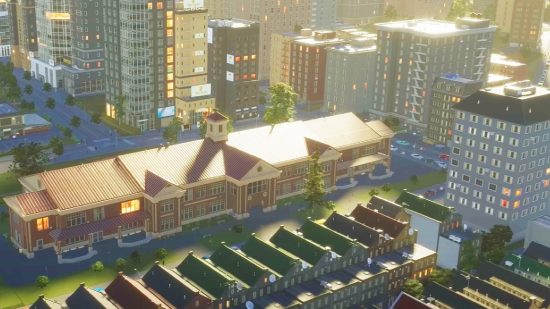What are the best Cities Skylines 2 settings? Early reports suggest that the PC performance on Cities Skylines 2 isn’t where it should be, and our testing unfortunately confirms this. We struggled to get any real consistency out of the game but did eventually determine what the best graphical and gameplay settings were for the testing rig we used.
Cities Skylines 2’s system requirements have been through a few revisions in the lead-up to release, and much has been said about its download size, given the comparison to the original game, so this makes the initial performance issues all the more disappointing.
Here are the best settings for Cities Skylines 2 on PC:
Best video settings for Cities Skylines 2
- VSync – Enabled
- Performance preference – Frame rate
- Dynamic resolution scale – Automatic
- Anti-Aliasing quality – High SMAA
- Global illumination – Medium
- Reflections quality – Medium
- Motion blur – disabled
- Shadow Quality – Medium
- Terrain quality – Medium
- Level of Detail – Medium
- Animation quality – Medium
- Texture quality – High
There is no benchmark tool built into Cities Skylines 2, so our testing was purely done on the basis of monitoring performance and carefully adjusting settings to improve it. With the above settings, we were able to get around 70 fps as an average but this was far from stable. Regardless of what settings we tested, whether it was a low preset or a custom configuration aiming for the best visual fidelity, there were always stability issues with Cities Skylines 2. Here are the key settings we changed throughout our testing.
Performance preference
While the performance preference option didn’t appear to limit or change any of the other visual settings we had in place, selecting this over balanced or simulation speed got us the closest to stability during our time testing Cities Skylines 2. However, this option sits in the general menu, not with the rest of the video settings.
Level of detail
A game like Cities Skylines has a surprising amount of detail to process, albeit not on the level of an open-world RPG, but still, there are benefits to squeezing as much quality out as possible. As we went through the settings, trying to wrangle a few extra frames, reducing our level of detail had a considerable positive impact, upping the average fps by around 10. While the overall number was still inconsistent, after reducing the level of detail, the drops were less frequent.
Anti-Aliasing
If you like smooth edges, anit-aliasing is your friend. We not only enabled AA, but had it set to high SMAA (subpixel morphological anti-aliasing). This places the responsibility for AA on the GPU to detect jagged edges and smooth them out. FXAA, Nvidia’s proprietary AA tech was an option but caused some blurring issues up close which is common, so SMAA was the way to go, and performance-wise, there was no impact of moving up to high rather than low SMAA.
Best gameplay settings for Cities Skylines 2
There are a few gameplay settings that you may want to consider changing in Cities Skylines 2 for the optimal experience.
- Start paused – Yes
- Edge scrolling – Yes
- Day/night visuals -Yes
- UI Transparency – 60%
- Temperature format – Farenheight
- Other units – US
Most of these settings are just box-ticking to ensure they’re enabled. The change to the UI transparency just helps with the immersion but everything is still more than visible and easy to identify.
For us, the game loaded with Celcius as the temperature and metric for the other units, again, change these if your preference suits. The only real option that, to us, is crucial to have on, is ‘start paused’. This ensures that any time to load a game, it is automatically paused to allow you some time to gather your thoughts before diving into gameplay.
What we use to test gaming settings
At PCGamesN, we like to use specific gaming rigs to test out the best video settings for performance in the latest releases. Currently, our test rigs include the following components; Intel Core i7 11700F, MSI Ventus Nvidia GeForce RTX 3070, 32GB of DDR4 3200MHz RAM, MSI B560 motherboard. We also test using Widows 11 64-bit.
We use the same rigs to ensure that every game we test is done under fair conditions against the same hardware. We will occasionally upgrade these rigs to ensure they don’t fall behind the market and this allows us to aim for the highest quality possible in every game we test.
Can Cities Skylines 2 be played using an HDD?
Cities Skylines 2 can not be played on an HDD. Storing the game on our HDD and booting it up worked, in the sense that the game loaded, but it was impossible to even navigate the main menu due to the lag being so bad.
You can upgrade to one of the best gaming SSDs to overcome this hurdle, as many future game releases will also start to shut down their support for the old-school drive.
How to monitor performance in Cities Skylines 2
If you want to keep an eye on performance in Cities Skylines 2, there is a simple way to do this depending on whether you’re using an Nvidia or AMD graphics card.
For Nvidia cards, ensure you have GeForce Experience installed and the in-game overlay enabled, and then simply hit ALT + R in-game to bring up your performance monitor.
With AMD cards, you can enable performance monitoring via the Radeon overlay using the shortcut CTRL + SHIFT + O.
Check out our Cities Skylines 2 review for our verdict on Paradox’s latest building sim. If you need to upgrade your hardware in preparation for launch, looking at the best graphics cards is always a good place to start.
